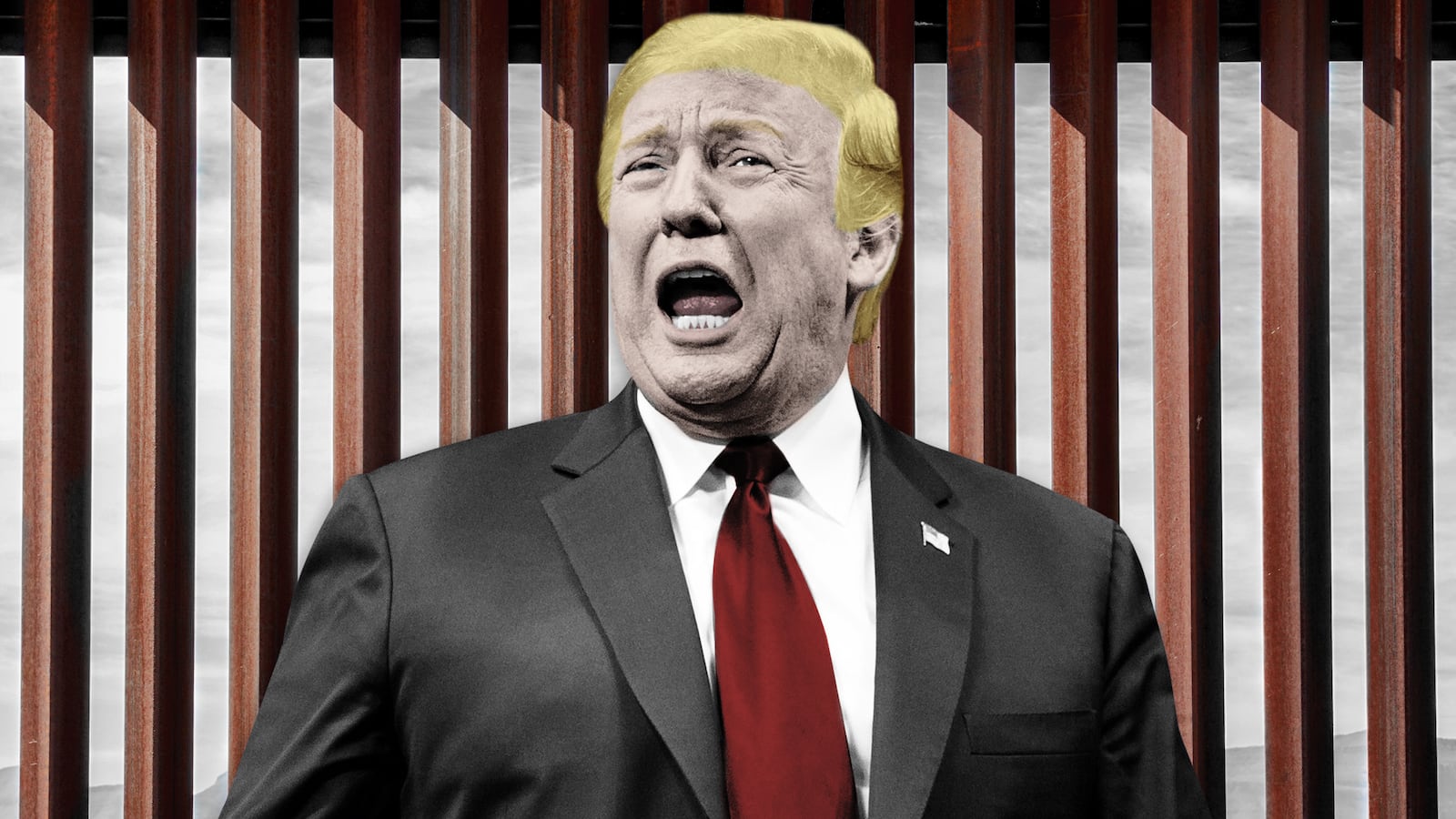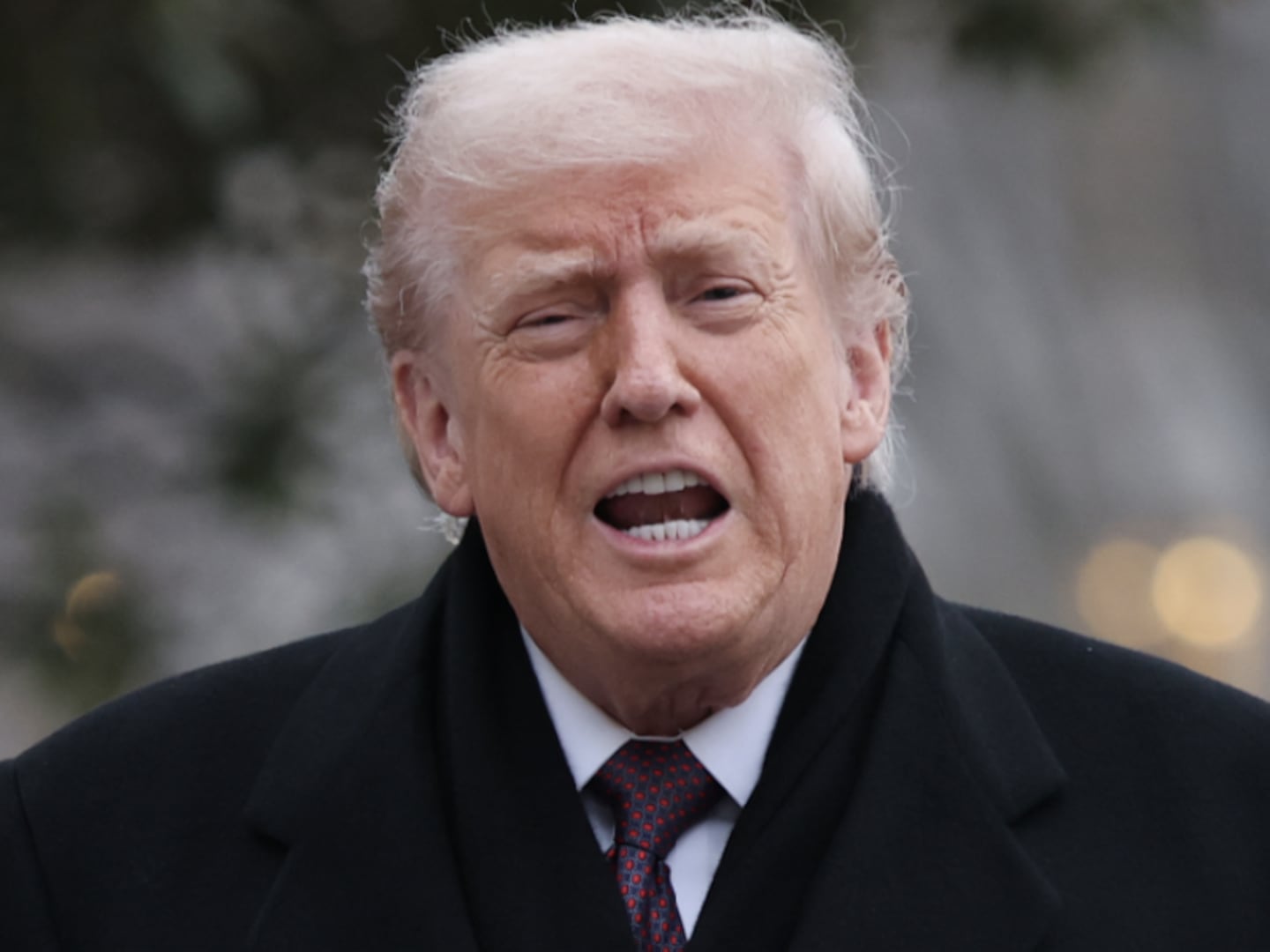Nearly three weeks into a federal shutdown that has stalled immigration courts, driven unpaid TSA workers to walk off the job, cancelled long-planned border inspections, and left America’s national parks overflowing with poop, President Donald Trump has so far refused to back down from his position that the government’s doors must remain closed until Congress appropriates funds for a wall along the U.S.-Mexico border.
But in the face of a breakdown of government services threatening America’s economy, security, and even food supply, a long-promised initial Trump plan for the border—to force Mexico, over the course of three days, to cut a $10 billion check made out to the U.S. Treasury—has been missing from the debate.
That proposal, titled “COMPELLING MEXICO TO PAY FOR THE WALL,” was the stuff of MAGA fan fiction. Rolled out in a two-page memo in April 2016, the plan, now deleted from the Trump campaign website but retrieved through web archives, was a surprisingly detailed strategy—by Trump campaign standards—for forcing Mexico to cut an 11-figure check to the United States.
The scheme entailed a three-day diplomatic high-wire act touching on creative interpretations of national security legislation, international finance, and the finer art of ransom, all meant to take place during Trump’s first three days in office.
First, Trump would issue a threat to change a rule under the USA PATRIOT Act to halt money transfers from undocumented Mexican nationals inside the United States back to Mexico. That money, known as remittances, amounts to roughly $25 billion annually and makes up nearly 3 percent of Mexico’s gross domestic product, according to the World Bank.
“It’s an easy decision for Mexico,” Trump wrote in the memo, an orphaned version of which still exists on the campaign website. “Make a one-time payment of $5-10 billion to ensure that $24 billion continues to flow into their country year after year.”
Upon issuing the threat, Trump would then respond to a (presumably panicking) Mexican government with a promise not to enact the proposed rule change—“if the Mexican government will contribute the funds needed to the United States to pay for the wall.”
“We have the moral high ground here, and all the leverage,” Trump concluded. “It is time we use it in order to Make America Great Again.”
The entire negotiation, Trump said at the time, would take just three days.
So what happened?
According to a former aide, the American people should have known to take Trump seriously, not literally.
“There were a lot of options in the air,” former Trump campaign adviser-turned-critic Sam Nunberg told The Daily Beast. The idea that Mexico would literally pay billions for the wall, Nunberg added, was “for political fodder,” rather than a legitimate policy proposal.
“It was going to be paid from them in terms of, they were going to get less money from the United States,” Nunberg said, noting that the campaign toyed with multiple funding sources for the wall, only some of which involved Mexico directly funding a wall.
Trump himself has repeatedly denied that there were any specific plans for Mexico to directly pay for the barrier, despite the call-and-response “Who’s gonna pay for the wall? MEXICO!” being such a staple of his campaign rallies that it’s even been remixed into a slow-jam on YouTube.
“Obviously, I never said and never meant, ‘they’re going to write out a check,’” Trump told reporters on Thursday morning. “Mexico will pay for the wall indirectly.”
For a figurative policy, however, Trump’s plan to force Mexico to fund a continuous concrete barrier along the 1,954-mile southern border—which eventually entailed extorting billions of dollars from the Mexican government—became pretty, well, concrete.
“In terms of specifying how Mexico would pay for the wall,” Nunberg said, “internally, it was going to come from Mexico one way or the other. It could come from cutting foreign aid that we give to Mexico, it could come from trade, or it could come from, let’s say, the remittances.”
The specific plan, then, was never meant to be the plan, specifically.
That might have been a good thing. Had “COMPELLING MEXICO TO PAY FOR THE WALL” left the planning stages and gone into production, serious legal and logistical problems with the brief would have killed Trump’s proposal in the crib.
For example, the plan invokes the USA PATRIOT Act to “issue detailed regulations” under 31 CFR § 130.120-121, using customer identification regulations to block payments from unauthorized residents of the United States to residents of Mexico. But there are no regulations at 31 CFR § 130.120-121—customer identification regulations are found in a completely different section.
But even misplaced financial regulations aside, much of Trump’s proposal was already enacted at the time he proposed it. In his plan, Trump declared that he would threaten to issue a regulation redefining “applicable financial institutions to include money transfer companies like Western Union.” But Western Union—and all other similar financial wire couriers—are already categorized as financial institutions under federal law, and have their own separate customer identification requirements.
Other proposed revenue streams for the president’s border wall in the document, including fees on visa applications, surcharges on remittance payments, and cancelling visas entirely, have similarly disappeared from Trump’s agenda—although it’s unclear why. The Border Wall Funding Act of 2017, a bill penned by Alabama Republican and longtime supporter of the president Rep. Mike Rogers, would add a 2-percent tax to all remittances sent to Central and South America “to be expended for improving border security,” nearly exactly what the president proposed as a supplemental measure to the remittance plan. That bill has been stalled out in committee since March 2017, when Republicans controlled both chambers of Congress.
The White House did not respond to multiple requests for comment as to why Trump dropped the remittance payment idea, whether the proposal was merely a rhetorical device, or how the president could square his statement that he “never said and never meant” that Mexico would directly pay for the wall with his own detailed plan for Mexico to pay for the wall.
Skeptics of the plan at the time it was revealed extended from President Barack Obama, who called the proposals “half-baked notions,” to future White House Chief of staff John Kelly, who reportedly considered the promise “uninformed.”
Alex Nowrasteh, a senior immigration policy analyst at the Cato Institute's Center for Global Liberty and Prosperity, told The Daily Beast that the notion Mexico would ever pay for the wall was extremely unlikely, even by Trump’s newest definition—and Trump almost certainly knew it.
“I suspect that Trump dropped that idea for three reasons: First, it wouldn’t raise enough revenue,” said Nowrasteh. “Second, remittances don’t go to the Mexican government so the threat wouldn’t carry much weight. Third, it would be very difficult to only tax illegal immigrants through such a tax.”
Even among Trump’s sundry broken campaign pledges—repealing Obamacare, defunding Planned Parenthood, ending birthright citizenship—not enacting a three-day foreign policy blitzkrieg to force Mexico to pay for a border wall is a whopper. Trump, who often campaigns in front of two enormous banners emblazoned “PROMISES MADE” and “PROMISES KEPT,” appears to have forgotten that promise, instead pointing to as-yet-unpassed trade negotiations with Mexico as evidence that Mexico will pay for the wall, one way or another.
“This barrier is absolutely critical to border security,” Trump said on Tuesday night in the first Oval Office address of his presidency, in which he claimed that “a growing humanitarian” crisis at the border necessitates the construction of a physical barrier to stem the flow of undocumented immigrants into the United States. “It’s also what our professionals at the border want and need. This is just common sense.”
After Congress appropriates $5.7 billion for a wall, the president added, “the border wall would very quickly pay for itself.”
Putting aside the fact that a border wall would do little to solve any of the problems highlighted in President Trump’s Oval Office speech, and that Trump has a better chance of persuading House Speaker Nancy Pelosi to fund stationing U.S. Customs and Border Protection agents along the border with a whip and a chair, the president privately gave up on hoping that Mexico would fulfill its end of the bargain less than a week into his presidency.
“You cannot say anymore that the United States is going to pay for the wall—I am just going to say that we are working it out,” Trump told Mexican president Enrique Peña Nieto on Jan. 27, 2017, according to a leaked transcript of the call. “Believe it or not, this is the least important thing that we are talking about, but politically this might be the most important talk about. But in terms of dollars—or pesos—it is the least important thing. I know how to build very inexpensively, so it will be much lower than these numbers I am being presented with, and it will be a better wall and it will look nice. And it will do the job.”






